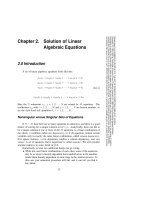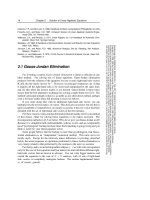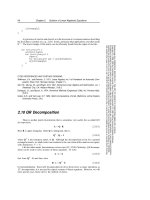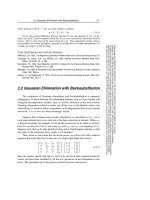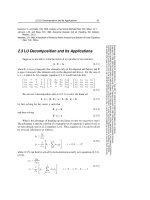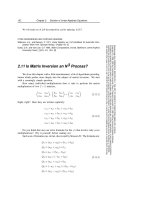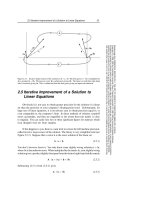ONE PARAMETER FAMILY OF LINEAR DIFFERENCE EQUATIONS AND THE STABILITY PROBLEM FOR THE NUMERICAL pdf
Bạn đang xem bản rút gọn của tài liệu. Xem và tải ngay bản đầy đủ của tài liệu tại đây (546.47 KB, 14 trang )
ONE PARAMETER FAMILY OF LINEAR DIFFERENCE
EQUATIONS AND THE STABILITY PROBLEM FOR
THE NUMERICAL SOLUTION OF ODEs
L. ACETO, R. PANDOLFI, AND D. TRIGIANTE
Received 21 July 2004; Accepted 4 October 2004
The study of the stability properties of numerical methods leads to considering linear dif-
ference equations depending on a complex parameter q. Essentially, the associated char-
acteristic polynomial must have constant type for q
∈ C
−
. Usually such request is proved
with the help of computers. In this paper, by using the fact that the associated polynomi-
alsaresolutionsofa“Legendre-type”difference equation, a complete analysis is carried
out for the class of linear multistep methods having the highest possible order.
Copyright © 2006 Hindawi Publishing Corporation. All rights reserved.
1. Introduction
The problem to approximate the solutions of differential equations by substituting to
them “appropriate” difference equations is as old as the differential calculus. Of course
the main problem to be solved is the control of the errors between the continuous and
the discrete solutions. In the fifties, the fundamental importance of the stability prop-
erties of the difference equations on the error propagation was recognized. After that, a
lot of efforts has been done in this field, mainly when the methods are applied to dissi-
pative problems. In such a case, the first approximation theorem permits to transform
the nonlinear problem into a linear one. Regarding the class of linear multistep meth-
ods (LMMs), the propagation of the errors can be studied by means of a linear difference
equation which, in the scalar case, depends on a complex parameter q
= hλ,whereh is the
stepsize and λ is the derivative at the critical point of the function defining the differential
equation. Obviously, the characteristic polynomial of the derived difference equation also
depends on the same parameter q.
The order of the equation of the error is, usually, greater than the one of the differential
equation. Therefore, an higher number of conditions are needed to get the solution we are
interested in. When all the conditions are fixed at the beginning of the interval of integra-
tion, it is well-known that the asymptotic stability of the zero solution of the error equa-
tion is equivalent to require that the characteristic polynomial is a Schur polynomial, that
is all its roots lie in the unit circle, for all q
∈ C
−
. On the contrary, when the conditions
are split between the beginning and the end of the interval of integration, the concept of
Hindawi Publishing Corporation
Advances in Difference Equations
Volume 2006, Article ID 19276, Pages 1–14
DOI 10.1155/ADE/2006/19276
2Difference equations and the stability problem
stability needs to be generalized. In such a case the notion of well-conditioning is more
appropriate. Essentially, such notion requires that under the perturbation δη of the im-
posed conditions, the perturbation of the solution δy should be bounded as follows:
δy≤δη, (1.1)
where is independent on the number of points in the discrete mesh.
It is worth to note that when the discrete equation is of higher order with respect to
the continuous initial value problem, it is not necessary to approximate the latter with
a discrete problem of the same type. In the case of first order differential equation, for
example, only the condition y
0
is provided by the continuous problem. The additional
conditions are at our disposal and we may fix them at our convenience. This is important
because the well-known Dahlquist barriers impose several limitations on the choice of the
methods in the class of LMMs used as initial value methods (IVMs). As matter of fact,
there are not methods with order greater than two having the critical point asymptoti-
cally stable for all q
∈ C
−
. When a discrete linear boundary value problem is considered,
the error equation is well-conditioned if the number of initial conditions is equal to the
number of roots of the char acteristic polynomial inside the unit circle and the number of
conditions at the end of the interval of integration is equal to the number of roots outside
the unit circle [2]. Once again, we will have a well-conditioned problem when a fixed set
of roots remains constantly inside the unit circle for all q
∈ C
−
. This result generalizes the
stability condition for IVMs where the roots inside need to be all of them.
In order to control that the number of roots inside the unit circle is constant for q
∈
C
−
, special importance assume the unit circumference and its image in the complex q-
plane (said boundary locus) under an appropriate map defined by each method. Except
for very simple cases, the proof that the number of roots inside the unit circle remains
constant for all q
∈ C
−
is only made by using the boundary locus pictures, provided by
computers.
In this paper we will consider the family of highest order methods in the class of LMMs
and we will give a complete proof that they are well-conditioned when used as boundary
value methods (BVMs), while, as proved in [3], they are unstable when used as IVMs.
The analysis will be done by studying a special linear difference equation with variable
coefficients (essentially the one satisfied by Legendre polynomials).
The paper is structured as follows: in Section 2 we will generalize the classical stability
concept for IVMs and we will introduce the highest possible order methods in the class
of LMMs. In Section 3 some properties of the polynomials associated to these methods
will be analyzed and, in Section 4, the related stability problem will be discussed. Finally,
some conclusions will be stated in Section 5.
2. The problem of stability for boundary value methods
As mentioned in the Introduction, the study of the stability for dissipative nonlinear
problems is made by linearizing the nonlinearity around the asymptotically stable critical
point. This is equivalent to examine the behavior of the solutions of a numerical method
L. Aceto et al. 3
when applied to the test equation
y
(t) = λy(t), t ∈
t
0
,T
,Reλ<0, (2.1)
subject to the initial condition y(t
0
) = y
0
.
By using a consistent k-step linear multistep method (LMM) on the discrete set
{t
}
defined by
t
= t
0
+ h, = 0,1, ,N, h =
T − t
0
N
, (2.2)
we get the following difference equation of order k:
k
j=0
α
j
− qβ
j
y
n+ j
= 0, q = hλ, k ≥ 1, (2.3)
where y
n+ j
, n = 0,1, ,N − k, approximates the value y(t
n+ j
) of the continuous solution
at the grid point t
n+ j
.
Denoting by e
n
= y(t
n
) − y
n
the error at t
n
, from the previous relation we obtain the
unperturbed error equation:
k
j=0
α
j
− qβ
j
e
n+ j
= 0, q = hλ. (2.4)
In order to study the stability of the zero solution of this equation, we consider the char-
acteristic polynomial defined by
π(z,q)
= ρ(z) − qσ(z), (2.5)
where
ρ(z)
=
k
j=0
α
j
z
j
, σ(z) =
k
j=0
β
j
z
j
. (2.6)
It is well-known that when (2.4) is coupled with k initial conditions, the asymptotic sta-
bility of its zero solution is equivalent to require that the characteristic polynomial π(z,q)
is a Schur polynomial for al l q
∈ C
−
. Such a choice of the additional conditions leads to
very severe restrictions on the order of methods (Dahlquist barr iers). To overcome this
drawback, since only y
0
is provided by the continuous problem, we can choose to fix
some of the (k
− 1) additional conditions at the beginning of the interval of integration
and the remaining at the end. Later on, we will refer to the discrete problem obtained
by associating to (2.3) k
1
initial conditions and k
2
= k − k
1
final ones as boundary value
method (BVM) with (k
1
,k
2
)-boundary conditions [2].
This allows to extend the classical stability concept. To this aim we consider the defi-
nition of type of a polynomial due to Miller [6].
4Difference equations and the stability problem
Definit ion 2.1. Apolynomialofdegreek is said to be of type (r
1
,r
2
,r
3
)ifithasr
1
zeros
inside the unit circle, r
2
zeros with unit modulus and r
3
zeros outside the unit circle, with
r
1
,r
2
,r
3
and k non-negative integers such that k = r
1
+ r
2
+ r
3
.
The following definition is the generalization to the case k
2
> 0 of the corresponding
well-known concepts valid only for the case k
2
= 0.
Definit ion 2.2. ABVMwith(k
1
,k
2
)-boundary conditions is said to be
- A
k
1
,k
2
-stable if C
−
⊆ Ᏸ
k
1
k
2
,where
Ᏸ
k
1
k
2
=
q ∈ C : π(z,q)isoftype
k
1
,0,k
2
(2.7)
denotes the region of (k
1
,k
2
)-Absolute stability;
- Perfectly A
k
1
,k
2
-stable if C
−
≡ Ᏸ
k
1
k
2
.
Remark 2.3. The terminology used in Numerical Analysis is often different from the one
used in the Difference Equations setting. In order to avoid confusion, it is worth to note
that the terms such as “stable methods” refer to the well-conditioning of the error equa-
tion and not necessarily to the stability of the zero solution of the same equation. It is
known that the well-conditioning of a linear boundary value problem, either continuous
or discrete, is related to the so called dichotomy. In the discrete case it essentially states
that the number of initial conditions should be equal to the number of roots of the char-
acteristic polynomial inside the unit circle and, of course, the number of conditions at
the end of the interval of integ ration should be equal to the number of roots outside the
unit circle.
Since our equations depend on the parameter q, the dichotomy should remain con-
stant for all q of interest, that is, q
∈ C
−
. Considering that the type of the polynomial
varies only if a root crosses the unit circle, an efficient way to establish if a numerical
method verifies the stability concepts given in Definition 2.2 is the knowledge of the form
and the position in the complex plane of the set
Γ
=
q ∈ C : π
e
iθ
,q
=
0, θ ∈ [0,2π)
, (2.8)
called boundary locus. The equation π(z,q)
= 0 defines a map between the complex z-
plane and the complex q-plane, that is,
q(z) =
ρ(z)
σ(z)
, (2.9)
consequently,
Γ
=
q ∈ C : q = q
e
iθ
, θ ∈ [0,2π)
. (2.10)
The request that the type of π(z,q) should not change for q
∈ C
−
is equivalent to Γ ∩ C
−
=
∅
. Usually, unless for simple cases, Γ is obtained graphically. In the sequel, we will give an
analytic expression of the boundary locus associated to each k-step LMM having highest
possible order, that is 2k, and constituting the so called Top Order family. These methods
L. Aceto et al. 5
are characterized by the following polynomials of degree k (see (2.6))
ρ
k
(z) =
k
j=0
α
(k)
j
z
j
, σ
k
(z) =
k
j=0
β
(k)
j
z
j
(2.11)
having real coefficients given by
α
(k)
j
= 2
j
r=1
1
r
−
k− j
r=1
1
r
β
(k)
j
, β
(k)
j
=
[k!]
2
(2k)!
k
j
2
, j = 0,1, ,k. (2.12)
Essentially, these coefficients were obtained by Dahlquist in [3] (in this more explicit
form they can be found in [1]). It is an easy matter to prove that the y satisfy the following
relations of symmetry:
α
(k)
j
=−α
(k)
k
− j
, β
(k)
j
= β
(k)
k
− j
, j = 0,1, ,k. (2.13)
Preliminary properties concerning ρ
k
(z)andσ
k
(z) can be now established.
Lemma 2.4. The polynomials ρ
k
(z) and σ
k
(z) with coefficients given by (2.12) satisfy the
following properties:
(1)
ρ
k
(z) =−z
k
ρ
k
z
−1
, σ
k
(z) = z
k
σ
k
z
−1
. (2.14)
(2) ρ
k
(1) = 0 for all k ≥ 1, ρ
k
(−1) = 0 for k even, σ
k
(−1) = 0 for k odd.
(3) If z
j
is any other root, different from 1 and −1,ofeachofthem,soisz
−1
j
.
(4) The function
ρ
k−1
(z) =
ρ
k
(z)
z − 1
(2.15)
is a symmetric polynomial, that is,
ρ
k−1
(z) = z
k−1
ρ
k−1
z
−1
, (2.16)
having positive coefficients.
Proof. Item (1) immediately follows by taking into account (2.11) and by using (2.13).
Moreover, (2) and (3) are easy consequence of (2.14). Concerning item (4), from (2.14)
we obtain
ρ
k−1
(z) =
−
z
k
ρ
k
z
−1
z − 1
=
z
k−1
ρ
k
z
−1
z
−1
− 1
= z
k−1
ρ
k−1
z
−1
. (2.17)
Since
ρ
k−1
(z) is a symmetric polynomial, in order to prove that its coefficients are all
positive, it is sufficient to evaluate the sign of the first ν of them, where
ν
=
⎧
⎪
⎪
⎪
⎨
⎪
⎪
⎪
⎩
k
2
for even k,
k +1
2
for odd k.
(2.18)
6Difference equations and the stability problem
By posing
ρ
k−1
(z) =
k−1
j=0
a
(k−1)
j
z
j
, (2.19)
from (2.15)weget
k
j=1
a
(k−1)
j
−1
z
j
−
k−1
j=0
a
(k−1)
j
z
j
=
k
j=0
α
(k)
j
z
j
. (2.20)
This implies that
a
(k−1)
j
= a
(k−1)
j
−1
− α
(k)
j
, j = 1, ,ν − 1,
a
(k−1)
0
=−α
(k)
0
.
(2.21)
Considering that α
(k)
0
and α
(k)
j
are negative quantities (see (2.12)), the previous relations
give the thesis.
From the above results we have that σ
k
(z)andρ
k−1
(z) have many basic common prop-
erties. Some of them can be summarized as follows:
symmetry: u
κ
(z) = z
κ
u
κ
(z
−1
),
positivity:thecoefficients are positive,
negat ive root: u
κ
(−1) = 0forκ odd,
where u
κ
(z) denotes either σ
k
(z)orρ
k−1
(z), and κ is the degree of the involved polyno-
mial.
Considerations based on the numerical concept of consistency permit to exclude that
the roots +1 and
−1 are multiple. In Section 3, however, such properties will b e directly
proved as consequence of the fact that ρ
k
(z)andσ
k
(z) satisfy a linear difference equation.
For the moment we assume that the real roots of such polynomials, on the unit circle, are
all simple. Concerning the map
q
k
(z) =
ρ
k
(z)
σ
k
(z)
=
ρ
k−1
(z)(z − 1)
σ
k
(z)
, (2.22)
by taking into account the statement (3) in Lemma 2.4 we obtain
q
k
(e
iθ
) =
⎧
⎪
⎪
⎪
⎪
⎪
⎪
⎪
⎨
⎪
⎪
⎪
⎪
⎪
⎪
⎪
⎩
e
i2θ
− 1
α
(k)
k
β
(k)
k
ν−1
j
=1
e
i2θ
−
υ
j
+ υ
−1
j
e
iθ
+1
ν
j
=1
e
i2θ
−
w
j
+ w
−1
j
e
iθ
+1
for even k,
e
iθ
− 1
e
iθ
+1
α
(k)
k
β
(k)
k
ν−1
j
=1
e
i2θ
−
υ
j
+ υ
−1
j
e
iθ
+1
e
i2θ
−
w
j
+ w
−1
j
e
iθ
+1
for odd k,
(2.23)
L. Aceto et al. 7
where υ
j
and w
j
are the roots of ρ
k
(z)andσ
k
(z), respectively, and ν is defined according
to (2.18). Considering (2.12), the previous relation becomes
q
k
e
iθ
=
⎧
⎪
⎪
⎪
⎪
⎪
⎪
⎨
⎪
⎪
⎪
⎪
⎪
⎪
⎩
2
k
r
=1
1
r
e
iθ
− e
−iθ
ν−1
j
=1
e
iθ
−
υ
j
+ υ
−1
j
+ e
−iθ
ν
j
=1
e
iθ
−
w
j
+ w
−1
j
+ e
−iθ
for even k,
2
k
r
=1
1
r
e
i(θ/2)
− e
−i(θ/2)
e
i(θ/2)
+ e
−i(θ/2)
ν−1
j
=1
e
iθ
−
υ
j
+ υ
−1
j
+ e
−iθ
e
iθ
−
w
j
+ w
−1
j
+ e
−iθ
for odd k,
=
⎧
⎪
⎪
⎪
⎪
⎪
⎪
⎨
⎪
⎪
⎪
⎪
⎪
⎪
⎩
isinθ
4
k
r
=1
1
r
ν−1
j
=1
2cosθ −
υ
j
+ υ
−1
j
ν
j
=1
2cosθ −
w
j
+ w
−1
j
for even k,
itan
θ
2
2
k
r
=1
1
r
ν−1
j
=1
2cosθ −
υ
j
+ υ
−1
j
2cosθ −
w
j
+ w
−1
j
for oddk,
.
=
⎧
⎪
⎨
⎪
⎩
isinθF
ν
(θ)forevenk,
itan
θ
2
G
ν−1
(θ)foroddk.
(2.24)
The following result holds true.
Theorem 2.5. Assuming that the multiplicity of the roots 1 and
−1 of both polynomials
ρ
k
(z) and σ
k
(z) is at most one, the values F
ν
(θ) and G
ν−1
(θ) are real numbers (possibly
infinite) for all θ
∈ [0,2π) .
Proof. It is trivial considering that if, for example, υ
j
is complex, the product will contain
both term (υ
j
+ υ
−1
j
) and its conjugate. The same, of course, holds for w
j
.
In order to have the type of π(z,q) constant for al l q ∈ C
−
, F
ν
(θ)andG
ν−1
(θ)haveto
preserve their sign for all θ
∈ [0,2π). From the expressions of F
ν
(θ)andG
ν−1
(θ), it turns
out that they are ratios of trigonometric polynomials. Although a large number of results
involving trigonometric polynomials are known (see [4, 5, 7], to quote only a few works
related to this subject), it seems that none of them can be here applied. For this reason in
the next section we will give a proof valid in our case.
3. Further propert ies of the associated polynomials
In order to state the main result, we need to establish further properties of the polynomi-
als ρ
k
(z)andσ
k
(z).
In [3] Dahlquist already stressed the relation between σ
k
(z)definedin(2.11)(divided
by a constant of normalization) and the Legendre polynomials
L
k
(x) =
x − 1
2
k
k
j=0
k
j
2
x +1
x − 1
j
, k = 0,1,2, (3.1)
In fact we have the following.
8Difference equations and the stability problem
Lemma 3.1. Let σ
k
(z) be the polynomial defined in (2.11). Then, for all k ≥ 0
σ
k
(z) =
(k!)
2
(2k)!
(z
− 1)
k
L
k
z +1
z − 1
. (3.2)
Proof. By setting in (3.1) z
= (x +1)/(x − 1), the thesis trivially follows by using (2.11)
and (2.12).
It is known that the Legendre polynomials verify the recurrence relation of the form
L
k+1
(x) =
2k +1
k +1
xL
k
(x) −
k
k +1
L
k−1
(x), k ≥ 1,
L
0
(x) = 1, L
1
(x) = x.
(3.3)
Then, we may prove the following result.
Theorem 3.2. The polynomial σ
k
(z),givenin(2.11), satisfies the difference equation
y
k+1
(z) =
z +1
2
y
k
(z) −
(z − 1)
2
4(4 − k
−2
)
y
k−1
(z), k ≥ 1, (3.4)
w ith initial conditions
y
0
(z) = 1, y
1
(z) =
z +1
2
. (3.5)
Proof. Fro m (3.2)onehas
σ
k+1
(z) =
[(k +1)!]
2
(2k +2)!
(z
− 1)
k+1
L
k+1
z +1
z − 1
. (3.6)
By using (3.3) in the previous relation we get
σ
k+1
(z) =
(k +1)!
2
(2k +2)!
(z
− 1)
k+1
2k +1
k +1
z +1
z − 1
L
k
z +1
z − 1
−
k
k +1
L
k−1
z +1
z − 1
. (3.7)
By direct calculation it is easy to check that
(k +1)!
2
(2k +2)!
2k +1
k +1
=
(k!)
2
2(2k)!
,
(k +1)!
2
(2k +2)!
k
k +1
=
(k − 1)!
2
4
4 − k
−2
(2k − 2)!
. (3.8)
Thus, relation (3.7)becomes
σ
k+1
(z) =
z +1
2
(k!)
2
(2k)!
(z
− 1)
k
L
k
z +1
z − 1
−
(z − 1)
2
4
4 − k
−2
·
(k − 1)!
2
(2k − 2)!
(z
− 1)
k−1
L
k−1
z +1
z − 1
.
(3.9)
Consequently, from Lemma 3.1 the thesis follows.
L. Aceto et al. 9
In order to tackle t he question concerning the values assumed by the polynomials
ρ
k−1
(z)andσ
k
(z) on the unit circle, we need to consider the following results.
Lemma 3.3. The coefficients defined in (2.12), character izing the polynomial ρ
k
(z),satisfy
the recurrence relation:
α
(k+1)
j
=
α
(k)
j
−1
+ α
(k)
j
2
−
α
(k−1)
j
−2
− 2α
(k−1)
j
−1
+ α
(k−1)
j
4(4 − k
−2
)
, j
= 0,1, ,k +1, k ≥ 1, (3.10)
with α
(0)
0
= 0, α
(1)
0
=−1, α
(1)
1
= 1 and α
(m)
s
= 0 for s<0 or s>m.
Proof. The proof follows by direct check.
Theorem 3.4. The polynomial ρ
k
(z),givenin(2.11), satisfies the difference equation (3.4)
w ith initial conditions
y
0
(z) = 0, y
1
(z) = z − 1. (3.11)
Proof. Fro m the relation (3.10)wecanwrite
k+1
j=0
α
(k+1)
j
z
j
=
k+1
j=0
α
(k)
j
−1
+ α
(k)
j
2
z
j
−
k+1
j=0
α
(k−1)
j
−2
− 2α
(k−1)
j
−1
+ α
(k−1)
j
4
4 − k
−2
z
j
. (3.12)
Considering our notational convention (α
(m)
s
= 0whenevers<0ors>m), the previous
relation becomes
k+1
j=0
α
(k+1)
j
z
j
=
1
2
k+1
j=1
α
(k)
j
−1
z
j
+
1
2
k
j=0
α
(k)
j
z
j
−
1
4
4 − k
−2
·
k+1
j=2
α
(k−1)
j
−2
z
j
− 2
k
j=1
α
(k−1)
j
−1
z
j
+
k−1
j=0
α
(k−1)
j
z
j
=
1
2
z
k
j=0
α
(k)
j
z
j
+
1
2
k
j=0
α
(k)
j
z
j
−
1
4
4 − k
−2
·
z
2
k
−1
j=0
α
(k−1)
j
z
j
− 2z
k−1
j=0
α
(k−1)
j
z
j
+
k−1
j=0
α
(k−1)
j
z
j
.
(3.13)
Then, from (2.11)wededucethat
ρ
k+1
(z) =
1
2
zρ
k
(z)+
1
2
ρ
k
(z) −
1
4
4 − k
−2
z
2
ρ
k−1
(z) − 2zρ
k−1
(z)+ρ
k−1
(z)
=
z +1
2
ρ
k
(z) −
z
2
− 2z +1
4
4 − k
−2
ρ
k−1
(z).
(3.14)
This completes the proof.
Lemma 3.5. The solutions ρ
k
(z) and σ
k
(z) of (3.4) are linearly independent.
10 Difference equations and the stability problem
Proof. Let us consider the Casorati matrix defined by
C(k)
=
ρ
k
(z) σ
k
(z)
ρ
k+1
(z) σ
k+1
(z)
. (3.15)
We have that
detC(0)
= de t
ρ
0
(z) σ
0
(z)
ρ
1
(z) σ
1
(z)
=
1 − z. (3.16)
Since for z
= 1(3.4) becomes of first order, it follows that detC(0) = 0. This implies the
thesis.
Theorem 3.6. Any solution of the difference equation (3.4) can be expressed as linear com-
bination of ρ
k
(z) and σ
k
(z).
Proof. The proof is an easy consequence of the fact that ρ
k
(z)andσ
k
(z) are a basis for the
space of solutions of (3.4).
Theorem 3.7. The polynomial ρ
k−1
(z),definedin(2.15), satisfies the difference equation
ρ
k
(z) =
z +1
2
ρ
k−1
(z) −
(z − 1)
2
4
4 − k
−2
ρ
k−2
(z), k ≥ 1, (3.17)
w ith initial conditions
ρ
−1
(z) = 0, ρ
0
(z) = 1. (3.18)
Proof. Fro m Theorem 3.4 and relation (2.15) the proof immediately follows.
We are now ready to answer the question concerning the values assumed by the poly-
nomials
ρ
k−1
(z)andσ
k
(z) on the unit circle.
Theorem 3.8. Let σ
k
(z) be the polynomial satisfying the difference equation (3.4).
Then, for m
≥ 1
σ
k
e
iθ
=
⎧
⎨
⎩
e
imθ
f
m
(θ), if k = 2m
e
iθ
+1
e
imθ
g
m
(θ), if k = 2m +1
(3.19)
with f
m
,g
m
:[0,2π) → (0,+∞).
Moreover, let
ρ
k−1
(z), b e the polynomial satisfying the difference equation (3.17).
Then, for m
≥ 1
ρ
k−1
e
iθ
=
⎧
⎨
⎩
e
iθ
+1
e
i(m−1)θ
f
m
(θ), if k = 2m
e
imθ
g
m
(θ), if k = 2m +1
(3.20)
with
f
m
, g
m
:[0,2π) → (0,+∞).
L.Acetoetal. 11
Proof. We consider only the case related to the polynomial σ
k
(z), being the other one very
similar.
The proof is by induction with respect to m.Form
= 1, from Theorem 3.2 it follows
that
σ
2
e
iθ
=
e
iθ
+1
2
σ
1
e
iθ
−
e
iθ
− 1
2
12
σ
0
e
iθ
=
e
iθ
+1
2
2
−
e
iθ
− 1
2
12
= e
iθ
3
e
i(θ/2)
+ e
−i(θ/2)
2
−
e
i(θ/2)
− e
−i(θ/2)
2
12
= e
iθ
2
cos(θ/2)
2
+1
3
= e
iθ
2+cosθ
3
= e
iθ
f
1
(θ).
(3.21)
Obviously, for each fixed θ
∈ [0,2π), f
1
(θ) is a positive real number. Moreover,
σ
3
e
iθ
=
e
iθ
+1
2
σ
2
e
iθ
−
e
iθ
− 1
2
15
σ
1
e
iθ
=
e
iθ
+1
2
e
iθ
2+cosθ
3
−
e
iθ
− 1
2
15
e
iθ
+1
2
=
e
iθ
+1
e
iθ
10 + 5cosθ +4
sin(θ/2)
2
30
=
e
iθ
+1
e
iθ
4+cosθ
10
=
e
iθ
+1
e
iθ
g
1
(θ),
(3.22)
with g
1
(θ) a positive real number for all θ ∈ [0,2π). We now show that if (3.19)holdsfor
m,italsoholdsform +1.
Weonlyconsiderthecaseofk even, because the proof for k odd proceeds similarly. By
applying (3.4)weobtain
σ
2m+2
e
iθ
=
e
iθ
+1
2
σ
2m+1
e
iθ
−
e
iθ
− 1
2
4
4 − (2m +1)
−2
σ
2m
e
iθ
=
e
iθ
+1
2
2
e
imθ
g
m
(θ) −
e
iθ
− 1
2
4
4 − (2m +1)
−2
e
imθ
f
m
(θ)
=
e
i(θ/2)
e
i(θ/2)
+ e
−i(θ/2)
2
2
e
imθ
g
m
(θ) −
e
i(θ/2)
e
i(θ/2)
− e
−i(θ/2)
2
4
4 − (2m +1)
−2
e
imθ
f
m
(θ)
= e
i(m+1)θ
2
cos
θ
2
2
g
m
(θ)+
sin(θ/2)
2
4 − (2m +1)
−2
f
m
(θ)
=
e
i(m+1)θ
f
m+1
(θ),
(3.23)
where, for each fixed θ
∈ [0,2π), f
m+1
(θ)isapositiverealnumber.
This completes the induction step.
12 Difference equations and the stability problem
Corollary 3.9. Suppose that the polynomials ρ
k
(z) and σ
k
(z),definedin(2.11), admit
roots on the unit circle. Then, all of them are real and simple.
Proof. Since f
m
(θ), g
m
(θ),
f
m
(θ)andg
m
(θ) are all positive in (3.19), (3.20)forallθ ∈
[0,2π), the only roots on |z|=1 are those coming from the factors (e
iθ
+1) and (e
iθ
−
1).
4. The stability problem for the top order family
The results obtained in the previous section permit to attack the question concerning the
stability problem for the k-step methods in the Top Order family, which will be used as
BVMs with (ν,k
− ν)-boundary conditions, where ν is defined according to (2.18).
Remark 4.1. From the statement (3) in Lemma 2.4 we have that ρ
k
(z)isoftype(r,k −
2r, r), with r a nonnegative integer. Analogously, we can derive that σ
k
(z)isoftype(s,k −
2s,s), with s ∈ N.
Theorem 4.2. Let ρ
k
(z) and σ
k
(z) be the polynomials defined in (2.11)andν ≥ 1 given by
(2.18). Then,
(1) ρ
k
(z) and σ
k
(z) arebothoftype(ν − 1,1,ν − 1),fork = 2ν − 1;
(2) ρ
k
(z) is of type (ν − 1,2,ν − 1) and σ
k
(z) is of type (ν,0,ν),fork = 2ν.
Proof. Fro m Corollary 3.9 it follows that, for k
= 2ν − 1, the polynomials ρ
k
(z)andσ
k
(z)
have only one root of unit modulus. Moreover, when k
= 2ν, ρ
k
(z) has two roots of unit
modulus and σ
k
(z) has not roots of unit modulus. Then, t he assertions of the theorem
follow from Remark 4.1.
We are now in the position to give the main results related to the stability problem.
Theorem 4.3. Let k
= 2ν − 1.Thek-step methods in the Top Order family are perfectly
A
ν,ν−1
-stable.
Proof. By considering the map defined in (2.22) and using Theorem 3.8 we obtain that
q
k
e
iθ
=
e
iθ
− 1
e
i(ν−1)θ
g
ν−1
(θ)
e
iθ
+1
e
i(ν−1)θ
g
ν−1
(θ)
, (4.1)
where
g
ν−1
(θ)/g
ν−1
(θ) = G
ν−1
(θ)isapositiverealnumberforallθ ∈ [0,2π). Conse-
quently,
q
k
e
iθ
=
e
i(θ/2)
− e
−i(θ/2)
e
i(θ/2)
+ e
−i(θ/2)
G
ν−1
(θ)=
2isin(θ/2)
2cos(θ/2)
G
ν−1
(θ)=itan
θ
2
G
ν−1
(θ), ∀θ ∈ [0,2π),
(4.2)
whichis0forθ
= 0and∞ for θ = π. This implies that the boundary locus associated to
the method coincides with the imaginary axis. It is understood that the north pole of the
Riemann sphere in the q-plane is considered, because the boundary locus is unbounded.
Consequently, it is a regular Jordan curve. According to the usual convention in complex
analysis, we can conclude that the region of the q-plane internal to the boundary locus is
the negative half complex plane. This completes the proof.
L.Acetoetal. 13
It is worth to note that the k-step methods in the Top Order family having k odd are
knowninliteratureastop order methods (TOMs) [2].
Theorem 4.4. Let k
= 2ν.Thek-step methods in the Top Order family are A
ν,ν
-stable.
Proof. Fro m (2.22)andTheorem 3.8 we obtain
q
k
e
iθ
=
e
i2θ
− 1
e
i(ν−1)θ
f
ν
(θ)
e
iνθ
f
ν
(θ)
, (4.3)
where 2(
f
ν
(θ)/f
ν
(θ)) = F
ν
(θ) is a positive real number for all θ ∈ [0,2π). Consequently,
q
k
e
iθ
=
e
i2θ
− 1
e
iθ
F
ν
(θ)
2
= isinθF
ν
(θ), ∀θ ∈ [0,2π). (4.4)
This implies that the boundary locus associated to the method coincides with the segment
of the imaginary axis
[
−iF,iF], where F = max
θ∈[0,2π)
F
ν
(θ). (4.5)
Then, the region of (ν,ν)-Absolute stability is the whole complex plane excluding this
segment. From Definition 2.2 the thesis follows.
5. Conclusions
In this paper it has been proved that the polynomials associated to the methods in the
Top Order family satisfy linear difference equations with variable coefficients. A complete
proof for the stability problem of such methods has been provided by using properties of
the polynomials derived from these equations.
References
[1] L. Aceto, The Pascal matrix and some numerical methods for ODEs, Tech. Rep. 01/01, Diparti-
mento di Energetica, Universit
`
a degli Studi di Firenze, Florence.
[2] L. Brugnano and D. Trigiante, Solving Differential Problems by Multistep Initial and Boundary
Value Methods, Stability and Control: Theory, Methods and Applications, vol. 6, Gordon and
Breach, Amsterdam, 1998.
[3] G. Dahlquist, Convergence and stability in the numerical integration of ordinary differential equa-
tions, Mathematica Scandinavica 4 (1956), 33–53.
[4] A. Gluchoff and F. Hart m ann, Univalent polynomials and non-negative trigonometric sums,The
American Mathematical Monthly 105 (1998), no. 6, 508–522.
[5] P. Henrici, Applied and Computational Complex Analysis, Pure and Applied Mathematics, vol. 1,
John Wiley & Sons, New York, 1974.
[6] J.J.H.Miller,On the location of zeros of certain classes of polynomials with applications to numer-
ical analysis, Journal of the Institute of Mathematics and Its Applications 8 (1971), 397–406.
14 Difference equations and the stability problem
[7] D. S. Mitrinovi
´
c, Analytic Inequalities, Die Grundlehren der mathematischen Wisenschaften, vol.
1965, Springer, New York, 1970.
L. Aceto: Dipartimento di Matematica Applicata “U. Dini,” Universit
`
a di Pisa, Via Diotisalvi 2,
56126 Pisa, Italy
E-mail address:
R. Pandolfi: Dipartimento di Matematica “U. Dini,” Universit
`
a di Firenze, Viale Morgagni 67/A,
50134 Firenze, Italy
E-mail address: pandolfi@math.unifi.it
D. Trigiante: Dipartimento di Energetica “S. Stecco,” Universit
`
a di Firenze, Via C. Lombroso 6/17,
50134 Firenze, Italy
E-mail address: trig iant@unifi.it

